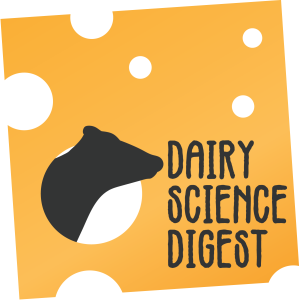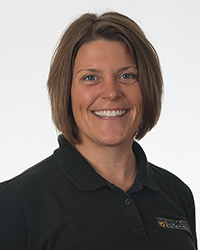Dairy Science Digest
Dairy Science Digest - a podcast developed to share the MOST current research published in the Journal of Dairy science. Hear directly from the research authors on how their results can impact your herd’s profitability. Science you can base your management decisions around. Designed to rarely exceed 30 minutes, this podcast provides ONLY the ”need to know” info for dairy producers. Keywords: dairy, science, reproduction, production, extension, cattle, MIZZOU, MU, Dairy Team, #2xAg2030
Episodes

Monday Jun 16, 2025
DSD 6.6 | How much variation is allowable?
Monday Jun 16, 2025
Monday Jun 16, 2025
DSD 6.6 | How much variability is allowable?
Timing of insemination is still one of the most common question Dr. Paul Fricke, Extension faculty for the University of Wisconsin, gets from farmers. This month he and coauthors Vanda Santos and Paulo Carvalho discuss the ideal timing of insemination when using popular artificial insemination protocols and when producers use estrus detection devices.
Additionally, how does this change if you choose to use sexed semen or a straw of beef?
Listen in to learn how to improve the pregnancies / AI metric in YOUR herd.
Topics of discussion
1:36 Introduction of Dr. Paul Fricke, Vanda Santos and Paulo Carvalho 2:48 OvSync history (1995): 0, 8, 16, 24 or 32 hours - timing of insemination 6:39 Exp. 1: Study Design – 0 vs 16 hour 7:55 Conception reductions due to cosync10:18 Exp. 2: Optimal time of sexed semen breeding11:43 Fig. 4: CR of Beef vs sexed semen 13:24 P/AI Results, sexed semen14:34 ReSync protocol - GGPPG 16:10 Exp. 3: Electronic estrus detection 18:00 Fig. 4: Conception, Early (0-2 hr) vs Late (20-25 hr) 19:49 Conception 13-23 hours after estrus detection 22:03 Raw data points on fig 3, Exp. 223:36 Fig 2: Early (0-2 hr) vs Ideal (15-16 hr) 24:27 Once a Day Breeding, killing the AM/PM rule 26:00 Expected pregnancy loss 28:49 What do you want “boots on the ground” dairymen to learn from this project?
Featured Article:
Effect of timing of artificial insemination with conventional or sex-sorted semen on fertility of lactating dairy cows
#2xAg2030; #journalofdairyscience; #openaccess; #MODAIRY; #conception; #ovsync; #doubleOvsync; #sexedsemen; #cosync; #resync; #pregnancyloss; #AM/PMrule; #dairysciencedigest; #ReaganBluel

Thursday May 15, 2025
DSD 6.5 | Performance of High protein Corn coproduct
Thursday May 15, 2025
Thursday May 15, 2025
For decades, ethanol production has generated affordable biproducts to feed. A new distilling method has generated a product with ~50% protein. Dr. Billy Brown, assistant professor of dairy science at Kansas State, wanted to understand how this feed would compare to soybean meal in a starter grain.
To test this he developed rations substituting soybean meal 1:1. Graduate student Rachel Skinner measured intake, growth, effiency and metabolic and digestive parameters to best understand if this product would work in post weaning phase of production.
Topics of discussion
1:19 Introduction of Dr. Billy Brooks3:18 Nutrient composition of high pro corn coproduct 5:14 Study Design6:33 Limiting Amino Acids 7:53 Age of calves 8:34 Starter Digestibility 10:40 Average Daily Gain (ADG)13:30 Insulin measurements 15:36 CP concentrations for the rations16:25 Heat Stress17:58 Dry matter intake and feed efficiency 19:05 Pelleting feasibility/stability 20:05 Yeast bodies – Impact, source of and future research efforts22:53 What do you want Boots on the Ground dairy producers to gain from the project? 23:32 Breakeven analysisFeatured Article:
Effects of a high-protein corn coproduct as a replacement for soybean meal in calf starter feed in the postweaning period
#2xAg2030; #journalofdairyscience; #openaccess; #MODAIRY; #HPCC; #dairycalves; #DDGS; # Protomax; #dairysciencedigest; #ReaganBluel; #Rachel Skinner

Thursday Apr 17, 2025
DSD 6.4 | A dynamic rumen, preweaning
Thursday Apr 17, 2025
Thursday Apr 17, 2025
Most dairy farms are trying to push the envelope from the conventional 4L of milk replacer per day to a higher volume to support lean structural growth of replacement heifers. Concerns of ruminal leakage resulting in fermentation has been cited as a concern, but is that based on an incomplete picture? We know microbial protein offers a nearly perfect alignment of amino acid requirements for the bovine, however nutrition programs have discounted milk replacer to exclusively providing rumen undegradable protein (RUP) – protein that skips the rumen and is absorbed in the abomasum.
Marcos Marcondes, researcher from the Miner Institute, wanted to see if feeding higher volumes would change the flow of protein and energy to the calf and the physiology of the rumen, due to leakage. To test this question he fed a standard rate and double rate of milk replacer with colbalt to mark and track the flow of digestion through preweaned animals.
Leakage was found in the rumen on both treatments, but the results were positive. Energy, in the form of volatile fatty acids, and microbial protein added to the fuel for these growing animals. Listen in to better understand the kinetics of digestion and questions that still remain for this phase of production.
Topics of discussion
1:44 Introduction of Dr. Marcos Marcondes2:50 Lambs as a model for bovine calves, 4 & 8L/day 4:07 Known info on the kinetics of milk protein 6:46 Relevance of microbial protein in fueling cattle8:17 Cobalt marker used in the research model 10:51 Rumen leakage for preweaned calves 13:14 Grain feeding during trial14:30 Milk replacer vs Whole milk 17:01 Retention rates 18:41 Colostrum protocol – no tubing20:02 VFA and Microbial protein production 25:37 Physiology and histology 27:32 What do you want Boots on the Ground dairy producers to gain from the project? Featured Article:
Influence of different amounts of milk replacer on esophageal leakage, rumen fermentation characteristics, gastrointestinal tract passage rate, and microbial crude protein synthesis of nursling animals
#2xAg2030; #journalofdairyscience; #openaccess; #MODAIRY; #prewean; #dairycalves; #microbialprotein; #MinerInstitute; #kinetics; #dairysciencedigest; #ReaganBluel;

Monday Mar 31, 2025
DSD 6.3 | Big Picture Management Decisions Matter
Monday Mar 31, 2025
Monday Mar 31, 2025
DSD 6.3 | Big Picture Management Decisions Matter
Timeless dairy management decisions, such as voluntary waiting period & days dry, have recently been the topic of interest across the globe. Scrutiny to illuminate the ideal to maximize productive life has left the industry questioning convention.
Michael Overton, DVM at Zoetis worked with co-author Steve Eicker to tease out the answers to these questions from a a massive dataset of 109,000 cows across 60 herds nationwide. This retrospective, observational research project was recently published in the Journal of Dairy Science titled, “Associations between days open and dry period length versus milk production, replacement, and fertility in the subsequent lactation in Holstein dairy cows”.
All dairymen should pause to determine the unintended consequences of their management decisions on optimal performance and ultimately the economic success of the herd. Listen in to learn ways to apply concepts from this project to your operation.
Topics of discussion
1:33 Introduction of Dr. Overton 2:54 Difference between association vs causation 4:28 Description of data set 4:51 Genomic testing, background 6:31 Advising herds on selection indices DWP$10:02 Different measurements collected – carry over impact of days dry and days open11:50 Figure 4: Impact of previous days open and previous days dry on cumulative milk 14:04 Risk of replacement and impact of mastitis18:05 How many sins is a dairyman willing to forgive? 19:46 What does your data say for optimal VWP 22:27 Twin events or sex of calf 24:59 Figure 7: Risk of pregnancy 28:46 What do you want Boots on the Ground dairy producers to gain from the project? Featured Article:
Associations between days open and dry period length versus milk production, replacement, and fertility in the subsequent lactation in Holstein dairy cows
#2xAg2030; #journalofdairyscience; #openaccess; #MODAIRY; #daysdry; #milk; #previousdaysopen; #VWP; #daysdry; #DWP$; #Zoetis; #dairysciencedigest; #ReaganBluel;

Saturday Feb 15, 2025
DSD 6.2 | Bump colostrum quality with ease
Saturday Feb 15, 2025
Saturday Feb 15, 2025
Colostrum, the life-giving liquid-gold first milk that builds the calves’ immune function. The dairy industry has made amazing strides on colostrum management, however we’ll always have a small number of cows that come in with enough colostrum, just moderate quality. What can we do to enhance the colostrum to ensure the calf’s success?
Dr. Sandra Godden, from the University of MN Vet Med, and her team of researchers sought to better understand what would happen if they directly added dry colostrum replacer to the moderate quality colostrum? Is it better to reconstitute and feed separately? Listen in to learn ways to improve your colostrum program and how to enhance that moderate quality colostrum.
Topics of discussion
1:47 Introduction of Dr. Sandra Godden2:29 Experimental design and “why” for the project 4:23 Efficiency of absorption 4:55 Abomasal emptying relative to osmolality 7:56 4 treatments 9:52 IgG concentrations at time 0 (Table 3) 10:52 Results discussion - IgG at 24 hours 12:21 General discussion of plasma derived colostrum vs maternal derived replacer15:05 Discussion of the actual product you used and how it is different from other products on the market17:45 Impact on health, behavior and appetite for the first 3 days 20:46 Importance of Total Coliform Counts (TCC) in colostrum and how to test25:26 What do you want Boots on the Ground dairy producers to gain from the project? 26:26 Goals for serum brix readings and serum total protein Featured Article:
Controlled Field Study Investigating Two Methods of Enriching Moderate-Quality Maternal Colostrum on Transfer of Passive Immunity and Wellbeing of Neonatal Dairy Calves
#2xAg2030; #journalofdairyscience; #openaccess; #MODAIRY; #colostrum; #colostrumreplacer; #colostrumenhancement; #premolac; #Zinpro; #dairysciencedigest; #ReaganBluel;

Wednesday Jan 15, 2025
DSD 6.1 | Management to create the invisible cow
Wednesday Jan 15, 2025
Wednesday Jan 15, 2025
DSD 6.1 | Management to create the invisible cow
If you pause and think about a list of cows – chances are the list that pops into mind is a group of troublemakers that didn’t breed back or need another round of treatment or are on this week’s cull list. What if you could create a herd of unmemorable cows – ones who just do their job; make milk, breed back, no mastitis – the "Invisible Cow". Dr. Krogstad’s research program’s goal is to create more invisible cows; ones you only see at calving, breeding and dry off. This month he shares with us a dataset analyzed for associations of hyperketonemia (HYK) with body condition, milk production, pregnancy loss, mastitis and ultimately culling.
It turns out that the timing of lipolysis determines if it is healthy or harmful and ultimately has a big impact on her success through transition. It all boils down to are the free fatty acids being mobilized to fuel early lactation being completely oxidized or partially oxidized?
Listen in to learn more about our featured article: Associations of Body Condition Score, Body Condition Score Change, and Hyperketonemia with Mastitis, Reproduction, and Milk Production
Topics of discussion
1:40 Introduction of Kirby Krogstad2:39 Definition of hyperketonemia (HYK)4:22 Frequency of HYK 5:16 Milk yield decrease due to hyperketonemia 7:36 Figure 3: Prepartum BCS by lactation9:39 Ideal range of prepartum BCS 10:17 Impact of BCS loss on pregnancy loss 12:04 What’s the biology behind the pregnancy losses? 13:58 How does hyperketonemia impact odds risk mastitis? 14:44 Cellular rationale behind increased mastitis risk16:36 Figure 5: Health status impact on milk yield18:16 “Healthy” Lipolysis 18:58 Were cows with high BHB treated? 19:43 Week one vs week two – Timing of Lipolysis 20:40 Healthy Lipolysis generates the invisible cow 22:11 Can you suppress inflammation to improve transition? 23:08 Lipolysis in week one 25:24 Culling association to hyperketonemia 26:15 BCS association to culling 27:27 Impact of stable BCS 28:14 Prevalence and goals for HYK 29:07 Rumen protected niacin for the transition herd 31:01 Transition BCS recommendations32:05 Take away for boots on the ground dairy producers
Featured Article:
Associations of Body Condition Score, Body Condition Score Change, and Hyperketonemia with Mastitis, Reproduction, and Milk Production
#2xAg2030; #journalofdairyscience; #openaccess; #MODAIRY; #InvisibleCow; #BCS; #ketosis; #pregnancyloss; #Maturecow; #transitiondairy; #HYK; #lipolysis; #dairysciencedigest; #ReaganBluel;

Sunday Dec 15, 2024
DSD 5.12 | Takes time to Make Time
Sunday Dec 15, 2024
Sunday Dec 15, 2024
Ever heard the adage, “It takes money to make money”? Well, the research highlighted this month shows that it also takes time, to make time. Dr. Zelmar Rodriguez discusses the importance of parlor training and how to make your on farm training as effective as possible. The featured article summarizes results of pre- and post-training assessments he and his team at MI State Vet Med recently completed.
Listen in to be motivated, a small effort can ultimately create a large impact in parlor performance and BTSCC.
Topics of discussion
1:49 Introduction of Dr. Zelmar Rodriguez2:45 What was the aim of the training project? 3:30 How to integrate photographs into training4:08 The difference in employees’ learning process. 5:13 The two curriculum sections, pathogens and milking processes 6:04 Where did you find the resources to use to make the training exams? 7:09 Specifics about the workers being trained and farms. 8:32 Results discussion 10:02 Should the manager/owner be present? 10:44 What question came up at every farm? 11:35 Cross Training 12:24 Pre-test knowledge level 13:05 Typical turnover rates 13:49 Average prep lag time, adequate prep 14:15 Time reduction in milking 15:36 BTSCC prior vs after intervention (April-Sept) 16:46 Clinical Mastitis identification 18:21 What is DeLaval PASS? 19:47 What is Cattle Care20:55 What do you want Boots on the Ground dairy producers to gain from the project?
Featured Article:
Impact of training dairy farm personnel on milking routine compliance, udder health, and milk quality
Recommended Resources – National Mastitis Council
#2xAg2030; #journalofdairyscience; #openaccess; #MODAIRY; #Training; #parlor; #dairylabor; #nmc; #DeLaval; #parlorturn; #milking; #dairysciencedigest; #ReaganBluel;

Monday Nov 18, 2024
DSD 5.11 | Subtle Sync changes to synergize estrus with ovulation
Monday Nov 18, 2024
Monday Nov 18, 2024
Reproductive physiologists are always trying to improve conception rates for the dairy herd. Double ovsync is one of the best tools in our toolbox to submit cows to first insemination. However, as estrus detection technology becomes more affordable and we learn more about physiology, perhaps combining the expression of estrus at insemination may improve fertility through optimizing ovulation timing.
Dr. Julio Giordano and Ana Laplacette worked with their Cornell reproduction team to investigate this theory on over 4600 cows in 2 commercial herds. “We are trying to take advantage of the power of sync of ovulation and the power of estrus” Giordano explains. “To get the best of both, synergize the two.”
The only change to the well-known Double ovsync protocol includes a delay in the final administration of GnRh before breeding. The goal, allowing the cows more time to show estrus. Take a moment to listen in to better understand the physiology of this synchronization program and how to improve your herd’s reproductive management.
Topics of discussion
2:03 Introduction of Dr. Julio Giordano & Ana Laplacette3:37 Why introduce Estrus detection to double ovsync? 6:25 Treatment description, Double ovsync9:12 Did you cherry pick? 10:04 What metrics do you focus in on to determine the success of synchronization protocol11:36 Considerations to grouping animals to best understand the data 13:57 How did you determine “heat” 15:23 Specific difference between G56 and G80 treatments 16:38 Increase in Estrus observed 2.2% vs 29.9% 17:09 Three types of cows – (1) Show estrus without GnRh, 1/3 (2) Show estrus after GnRh, 1/3 (3) Never show estrus, 1/3 20:01 Anestrus cows – table 5 22:16 Follicle size differences between treatment26:12 Did it work? Take home message for boots on the ground dairy producers 30:41 What is the difference between the estrus and non-estrus cows? 32:16 Follow up project: Give cows 1 week to show estrus after PGH of breeding OvSync
Featured Article:
Delaying induction of ovulation and timed AI in a Double-Ovsynch protocol increased expression of estrus and altered first service reproductive outcomes of lactating dairy cows
#2xAg2030; #journalofdairyscience; #openaccess; #MODAIRY; #DoubleOvSync; #G56; #G80; #cherrypick; #sync; #estrus; #dairy; #Lut; #GnRH; #conceptionrate; #dairysciencedigest; #ReaganBluel;

Wednesday Oct 16, 2024
DSD 5.10 | Rumen friendly fatty acids in High Oleic Beans
Wednesday Oct 16, 2024
Wednesday Oct 16, 2024
DSD 5.10 | Rumen friendly fatty acids in High Oleic Beans
Soybeans and dairy cows have walked hand for decades. These oil beans are known specifically for the amino acid sequence in their high-quality protein and energy to support lactation. Recent developments in plant breeding has shifted the fat profile of the bean contain a higher amount of Oleic fat, which is easier for the rumen to digest, in certain varieties. Substituting linoleic acid for higher concentrations of oleic allows nutritionists to increase the inclusion rate in the diet and therefore support the herd during times of high production. This month we feature an article from Dr. Adam Lock and his team at Michigan State University as highlighting research generated from on-farm questions.
Ensuring producers know how much to feed, and how to feed high oleic soybeans to the herd was the objective of a series of research projects in the pipeline of publications due to come from MSU in the coming months and years. Listen in to here if growing this new variety of bean makes sense for your operation.
Topics of discussion
1:56 Introduction of Adam Lock 3:37 What’s the difference between conventional beans and HOSB?7:41 Raw vs Roasted10:38 Research Treatments, 4 rations 12:28 Table 2 – Statistical Contrasts13:24 ECM impacts 16:48 Sourcing HOSB18:45 Future research questions19:34 Palmitic acid for milk fat improvements 21:03 Upcoming transition cow research 22:43 HOSB impacts on metabolism – research in works24:10 DMI/ECM25:03 Take home message for boots on the ground dairy producers27:28 On-Farm Roasting
Featured Article:
Effects of raw and roasted high oleic soybeans on milk production of high-producing dairy cows
Supporting Article:
Effects of increasing dietary inclusion of high oleic acid soybeans on milk production of high-producing dairy cows
#2xAg2030; #journalofdairyscience; #openaccess; #MODAIRY; #HighOleic ; #soybean; #Plenish; #soyleic; #HOSB; #ration; #dairy; #rumen; #FA; #oleic; #dairysciencedigest; #ReaganBluel;

Monday Sep 16, 2024
DSD 5.9 | Undegradable NDF clogging your herd?
Monday Sep 16, 2024
Monday Sep 16, 2024
Despite decades of dedicated research, the rumen still remains a bit of a ‘black box’. This month we feature an article from Dr. Gonzalo Ferreira and his team at Virginia Tech as they try further define how undegradable fiber impacts the rumen's flow rate, and therefore productivity.
Comprehending the kinetics of degradation will assist in identifying the ideal combination of ingredients to create a profitable ration for your herd.
Could this help you make future planting decisions, as the nation is repairing from several rounds of drought? Does the ‘queen of forages’ belong in your cropping program?
Listen in to learn more!
Topics of discussion
1:48 Introduction of Dr. Gonzalo Ferreira 3:33 Impact of Fiber in the ration4:15 Compare Alfalfa to temperate grasses 5:16 Segregating Fiber, pdNDF vs uNDF8:04 Design of research rations 9:23 Feeding grasses to lactating dairy cows 12:40 Main variable of interest, ruminal passage rate 13:34 Dry matter intake 16:03 Ration strategy around flow rates and rumen pool size 19:08 Forage sample analysis selection 21:21 Cost of the rations23:32 Plant more Alfalfa or Orchard Grass? 26:36 Take home message for boots on the ground dairy producers
Featured Article:
Ruminal passage rate and digestibility of fiber from dairy cows consuming diets containing alfalfa and orchardgrass hays with different concentrations of undegradable neutral detergent fiber (uNDF)
#2xAg2030; #journalofdairyscience; #openaccess; #MODAIRY; #queenofforages; #Alfalfa; #NDF; #uNDF; #pdNDF; #orchardgrass; #ration; #kinetics; #dairy; #rumen; #dairysciencedigest; #ReaganBluel;

Reagan Bluel
As dairy specialist at the University of Missouri, I am passionate about providing research based information to dairy producers in a format easy to listen to.
Log in every month to learn straight from the researchers, information that could transform your herd.
For more information reach out at reagan@modairy.org or bluelrj@missouri.edu










